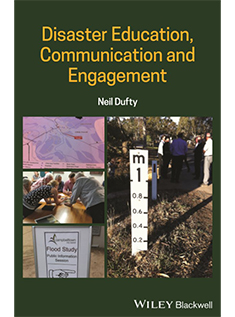 Author
Author
Neil Dufty, Molino Stewart Pty Ltd, Parramatta, NSW, Australia
Reviewed by
Adjunct Professor Jim McLennan, La Trobe University, Melbourne
Published by
Wiley Blackwell
ISBN: 9781119569794
The title of the book could quite reasonably be extended to read—'or how to go beyond just putting information and templates on my agency website’.
In his introduction, author Neil Dufty describes his book as offering ‘…a bridge between academic theory and research, and disaster learning practice’ intended to enable ‘…practitioners to prepare effective disaster learning plans, programs and activities’. With its linking of education, communication and engagement as central to effective community-based disaster risk reduction, the book is a very welcome addition to the quite limited material available about how to develop and implement effective community-focused safety programs.
In my opinion, the book will be of particular value to 2 readerships coming new to the field of community engagement within emergency management agencies and related organisations. Those with a background in community development or adult education, and those with a background in emergency planning and response. For the former, Part I provides a comprehensive primer covering the important definitions, topics, issues and concepts that constitute the world of emergency management. For the latter, Part II provides a very accessible account of how to think about, and go about, providing effective programs at local levels to raise resident preparedness for disaster events.
This is not to say that only half the book will be useful to each readership! For those with an operational background, Part I emphasises the social dimensions of disaster vulnerabilities, the importance of working at the local level and the limited effectiveness of a top-down command-and control approach to the community engagement and education endeavour. For those with a background in community development or adult education, Part II is replete with ‘how to’ ways of going about communicating and engaging at local levels to address both risk awareness deficits and awareness—preparation gaps.
Turning to specifics, I think that the account in Chapter 4 of applying a program logic-model approach to disaster education programs is very useful. The introduction to the rather contested concept of disaster resilience in Chapters 5 and 10 is refreshingly concise. The framework for tailoring disaster education, communication and engagement programs suggested in Chapter 6 provides a helpful way to organise thinking about the complexities likely to bedevil developing a collaborative program in a particular location with its unique issues.
The typology of education, communication and engagement methods presented in Chapter 9 I found quite inspirational. Apart from the 2 readerships I have mentioned, the book is well-suited to be a text or a reference for advanced undergraduate and postgraduate courses in emergency management and natural hazard risk mitigation. Although such courses seem to be rather sparse on the Australian higher education scene, at least in comparison with North America, the UK and Europe. For any second edition, I suggest that it include an author index and a database of illustrative reports about education, communication and engagement programs that have been implemented in Australia
The world-weary cynic, which I have become, cannot conclude without a statement of the bleeding obvious: disaster education, communication and engagement programs such as those advocated in this book will only make a meaningful difference to community safety (in a world of global warming and increased danger from natural hazards) if they are adequately funded and resourced by all levels of government.


